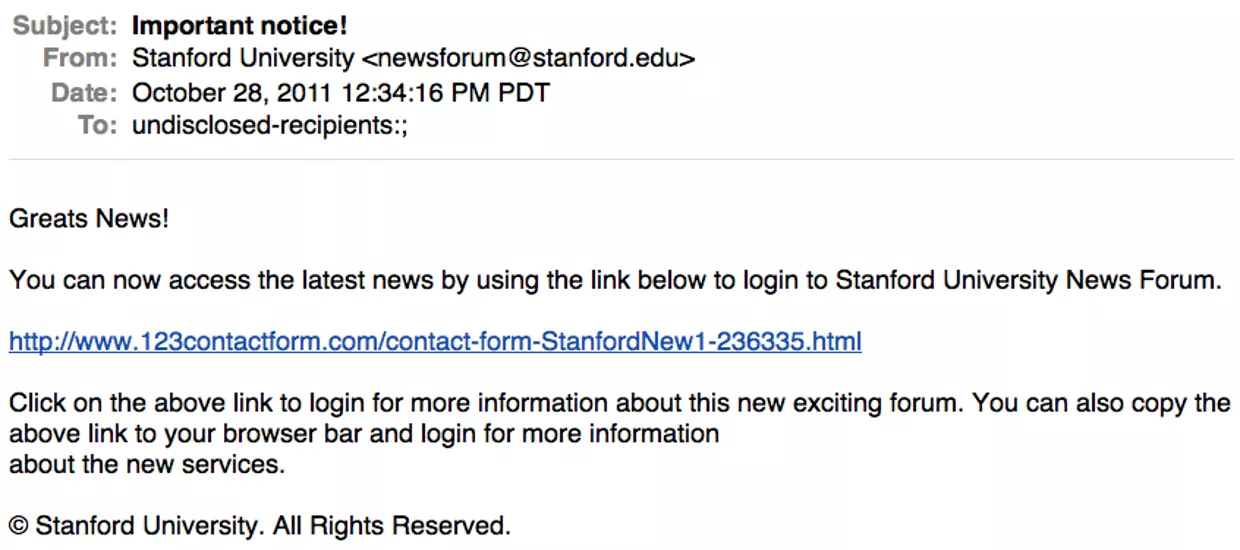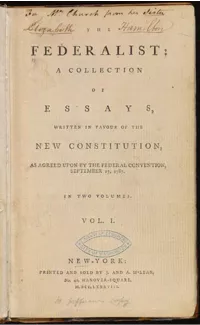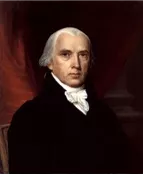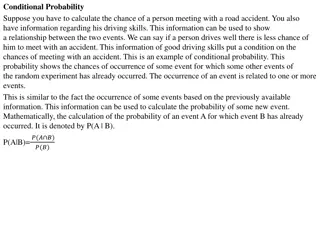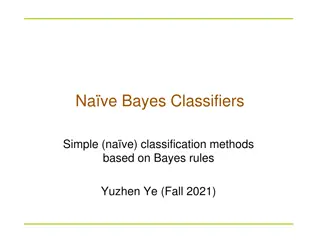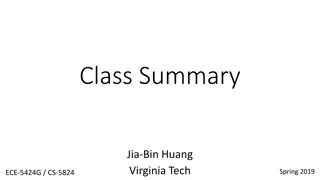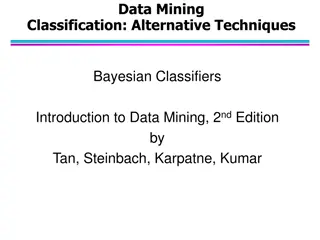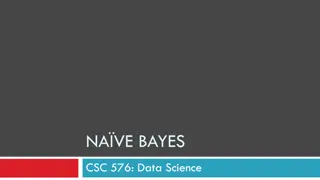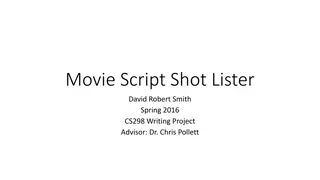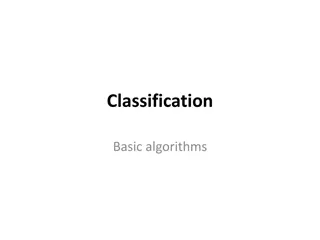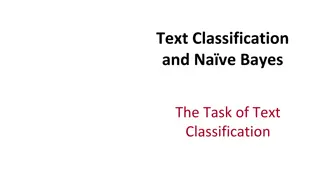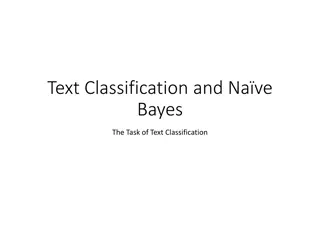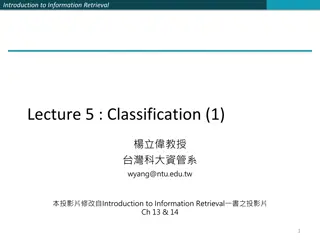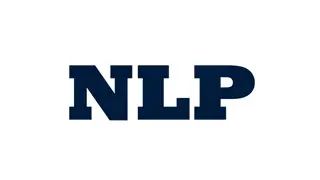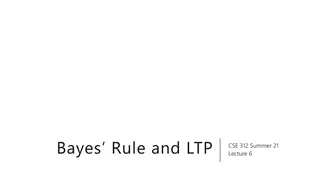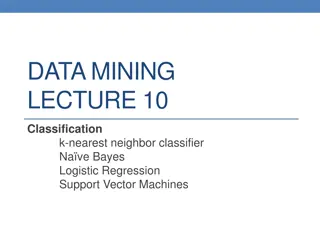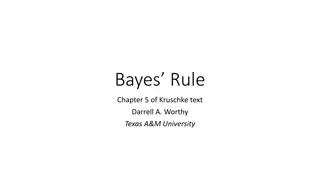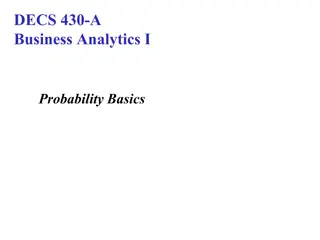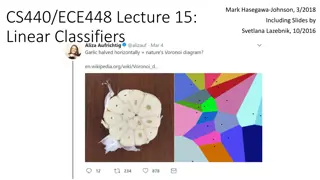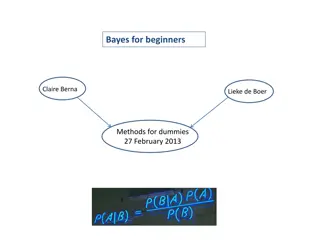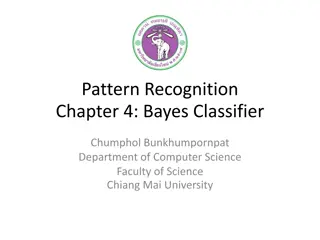Text Classification and Naive Bayes in Action
In this content, Dan Jurafsky discusses various aspects of text classification and the application of Naive Bayes method. The tasks include spam detection, authorship identification, sentiment analysis, and more. Classification methods like hand-coded rules and supervised machine learning are explored, highlighting the importance of assigning subject categories accurately. The discussion encompasses the use of Bayesian methods in solving authorship disputes of the Federalist papers as well.
Download Presentation

Please find below an Image/Link to download the presentation.
The content on the website is provided AS IS for your information and personal use only. It may not be sold, licensed, or shared on other websites without obtaining consent from the author.If you encounter any issues during the download, it is possible that the publisher has removed the file from their server.
You are allowed to download the files provided on this website for personal or commercial use, subject to the condition that they are used lawfully. All files are the property of their respective owners.
The content on the website is provided AS IS for your information and personal use only. It may not be sold, licensed, or shared on other websites without obtaining consent from the author.
E N D
Presentation Transcript
Text Classification and Na ve Bayes The Task of Text Classification
Dan Jurafsky Is this spam?
Dan Jurafsky Who wrote which Federalist papers? 1787-8: anonymous essays try to convince New York to ratify U.S Constitution: Jay, Madison, Hamilton. Authorship of 12 of the letters in dispute 1963: solved by Mosteller and Wallace using Bayesian methods James Madison Alexander Hamilton
Dan Jurafsky Positive or negative movie review? unbelievably disappointing Full of zany characters and richly applied satire, and some great plot twists this is the greatest screwball comedy ever filmed It was pathetic. The worst part about it was the boxing scenes. 4
Dan Jurafsky What is the subject of this article? MeSH Subject Category Hierarchy MEDLINE Article Antogonists and Inhibitors Blood Supply Chemistry Drug Therapy Embryology Epidemiology ? 5
Dan Jurafsky Text Classification Assigning subject categories, topics, or genres Spam detection Authorship identification Age/gender identification Language Identification Sentiment analysis
Dan Jurafsky Text Classification: definition Input: a document d a fixed set of classes C ={c1, c2, , cJ} Output: a predicted class c C
Classification Methods: Hand-coded rules Dan Jurafsky Rules based on combinations of words or other features spam: black-list-address OR ( dollars AND havebeen selected ) Accuracy can be high If rules carefully refined by expert But building and maintaining these rules is expensive
Dan Jurafsky Classification Methods: Supervised Machine Learning Input: a document d a fixed set of classes C ={c1, c2, , cJ} A training set of m hand-labeled documents (d1,c1),....,(dm,cm) Output: a learned classifier :d c 9
Classification Methods: Supervised Machine Learning Dan Jurafsky Any kind of classifier Na ve Bayes Logistic regression Support-vector machines k-Nearest Neighbors
Text Classification and Naive Bayes The Naive Bayes Classifier
Naive Bayes Intuition Simple ("naive") classification method based on Bayes rule Relies on very simple representation of document Bag of words
The bag of words representation seen sweet 2 1 ( )=c whimsical 1 recommend happy 1 1 ... ...
Bayes Rule Applied to Documents and Classes For a document dand a class c P(c|d)=P(d |c)P(c) P(d)
Naive Bayes Classifier (I) cMAP=argmax P(c|d) MAP is maximum a posteriori = most likely class c C P(d |c)P(c) P(d) P(d |c)P(c) =argmax c C =argmax c C Bayes Rule Dropping the denominator
Naive Bayes Classifier (II) "Likelihood" "Prior" cMAP=argmax P(d |c)P(c) c C Document d represented as features x1..xn =argmax c C P(x1,x2, ,xn|c)P(c)
Nave Bayes Classifier (IV) cMAP=argmax P(x1,x2, ,xn|c)P(c) c C O(|X|n |C|) parameters How often does this class occur? Could only be estimated if a very, very large number of training examples was available. We can just count the relative frequencies in a corpus
Multinomial Naive Bayes Independence Assumptions P(x1,x2, ,xn|c) Bag of Words assumption: Assume position doesn t matter Conditional Independence: Assume the feature probabilities P(xi|cj) are independent given the class c. P(x1, ,xn|c)=P(x1|c) P(x2|c) P(x3|c) ... P(xn|c)
Multinomial Naive Bayes Classifier cMAP=argmax P(x1,x2, ,xn|c)P(c) c C cNB=argmax P(cj) P(x|c) c C x X
Applying Multinomial Naive Bayes Classifiers to Text Classification positions all word positions in test document cNB=argmax P(cj) P(xi|cj) cj C i positions
Problems with multiplying lots of probs There's a problem with this: cNB=argmax P(cj) P(xi|cj) cj C i positions Multiplying lots of probabilities can result in floating-point underflow! .0006 * .0007 * .0009 * .01 * .5 * .000008 . Idea: Use logs, because log(ab) = log(a) + log(b) We'll sum logs of probabilities instead of multiplying probabilities!
We actually do everything in log space cNB=argmax P(cj) P(xi|cj) Instead of this: cj C i positions This: Notes: 1) Taking log doesn't change the ranking of classes! The class with highest probability also has highest log probability! 2) It's a linear model: Just a max of a sum of weights: a linear function of the inputs So naive bayes is a linear classifier
Text Classification and Naive Bayes The Naive Bayes Classifier
Text Classification and Na ve Bayes Naive Bayes: Learning
Sec.13.3 Learning the Multinomial Naive Bayes Model First attempt: maximum likelihood estimates simply use the frequencies in the data ??? ?????? ? ?? = count(wi,cj) count(w,cj) w V P(wi|cj)=
Parameter estimation count(wi,cj) count(w,cj) w V fraction of times word wi appears among all words in documents of topic cj P(wi|cj)= Create mega-document for topic j by concatenating all docs in this topic Use frequency of w in mega-document
Sec.13.3 Problem with Maximum Likelihood What if we have seen no training documents with the word fantastic and classified in the topic positive (thumbs-up)? P("fantastic" positive) =count("fantastic", positive) = 0 count(w,positive ) w V Zero probabilities cannot be conditioned away, no matter the other evidence! cMAP=argmaxc P(c) P(xi|c) i
Laplace (add-1) smoothing for Nave Bayes count(wi,c)+1 count(w,c)+1 ( w V w V count(wi,c) count(w,c) ( P(wi|c)= P(wi|c)= ) ) count(wi,c)+1 = +V count(w,c ) w V
Multinomial Nave Bayes: Learning From training corpus, extract Vocabulary Calculate P(wk| cj)terms Textj single doc containing all docsj Foreach word wkin Vocabulary nk # of occurrences of wkin Textj Calculate P(cj)terms For each cj in C do docsj all docs with class =cj |docsj| P(cj) nk+a P(wk|cj) |total # documents| n+a |Vocabulary|
Unknown words What about unknown words that appear in our test data but not in our training data or vocabulary? We ignore them Remove them from the test document! Pretend they weren't there! Don't include any probability for them at all! Why don't we build an unknown word model? It doesn't help: knowing which class has more unknown words is not generally helpful!
Stop words Some systems ignore stop words Stop words: very frequent words like the and a. Sort the vocabulary by word frequency in training set Call the top 10 or 50 words the stopword list. Remove all stop words from both training and test sets As if they were never there! But removing stop words doesn't usually help So in practice most NB algorithms use all words and don't use stopword lists
Text Classification and Naive Bayes Naive Bayes: Learning
Sentiment and Binary Naive Bayes Text Classification and Naive Bayes
A worked sentiment example with add-1 smoothing 1. Prior from training: P(-) = 3/5 P(+) = 2/5 ??? ?????? ? ?? = 2. Drop "with" 3. Likelihoods from training: ????? ??,? + 1 ? ?????? ?,? 4. Scoring the test set: ? ??? = + |?|
Optimizing for sentiment analysis For tasks like sentiment, word occurrence seems to be more important than word frequency. The occurrence of the word fantastic tells us a lot The fact that it occurs 5 times may not tell us much more. Binary multinominal naive bayes, or binary NB Clip our word counts at 1 Note: this is different than Bernoulli naive bayes; see the textbook at the end of the chapter.
Binary Multinomial Nave Bayes: Learning From training corpus, extract Vocabulary Calculate P(wk| cj)terms Remove duplicates in each doc: For each word type w in docj Retain only a single instance of w Calculate P(cj)terms For each cj in C do docsj all docs with class =cj Textj single doc containing all docsj Foreach word wkin Vocabulary nk # of occurrences of wkin Textj |docsj| P(cj) nk+a P(wk|cj) |total # documents| n+a |Vocabulary|
Binary Multinomial Naive Bayes on a test document d First remove all duplicate words from d Then compute NB using the same equation: cNB=argmax P(cj) P(wi|cj) cj C i positions 39
Binary multinominal naive Bayes Counts can still be 2! Binarization is within-doc!
Sentiment and Binary Naive Bayes Text Classification and Naive Bayes
More on Sentiment Classification Text Classification and Naive Bayes
Sentiment Classification: Dealing with Negation I really like this movie I really don't like this movie Negation changes the meaning of "like" to negative. Negation can also change negative to positive-ish Don't dismiss this film Doesn't let us get bored
Sentiment Classification: Dealing with Negation Das, Sanjiv and Mike Chen. 2001. Yahoo! for Amazon: Extracting market sentiment from stock message boards. In Proceedings of the Asia Pacific Finance Association Annual Conference (APFA). Bo Pang, Lillian Lee, and Shivakumar Vaithyanathan. 2002. Thumbs up? Sentiment Classification using Machine Learning Techniques. EMNLP-2002, 79 86. Simple baseline method: Add NOT_ to every word between negation and following punctuation: didn t like this movie , but I didn t NOT_like NOT_this NOT_movie but I
Sentiment Classification: Lexicons Sometimes we don't have enough labeled training data In that case, we can make use of pre-built word lists Called lexicons There are various publically available lexicons
MPQA Subjectivity Cues Lexicon Theresa Wilson, Janyce Wiebe, and Paul Hoffmann (2005). Recognizing Contextual Polarity in Phrase-Level Sentiment Analysis. Proc. of HLT-EMNLP-2005. Riloff and Wiebe (2003). Learning extraction patterns for subjective expressions. EMNLP-2003. Home page: https://mpqa.cs.pitt.edu/lexicons/subj_lexicon/ 6885 words from 8221 lemmas, annotated for intensity (strong/weak) 2718 positive 4912 negative + : admirable, beautiful, confident, dazzling, ecstatic, favor, glee, great : awful, bad, bias, catastrophe, cheat, deny, envious, foul, harsh, hate 49
The General Inquirer Philip J. Stone, Dexter C Dunphy, Marshall S. Smith, Daniel M. Ogilvie. 1966. The General Inquirer: A Computer Approach to Content Analysis. MIT Press Home page: http://www.wjh.harvard.edu/~inquirer List of Categories: http://www.wjh.harvard.edu/~inquirer/homecat.htm Spreadsheet: http://www.wjh.harvard.edu/~inquirer/inquirerbasic.xls Categories: Positiv (1915 words) and Negativ (2291 words) Strong vs Weak, Active vs Passive, Overstated versus Understated Pleasure, Pain, Virtue, Vice, Motivation, Cognitive Orientation, etc Free for Research Use
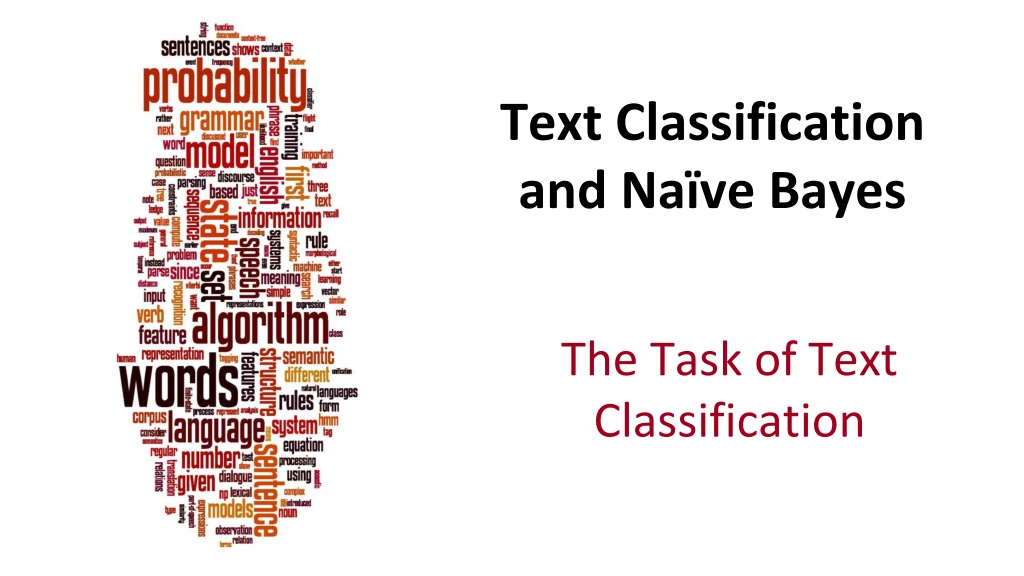
 undefined
undefined




